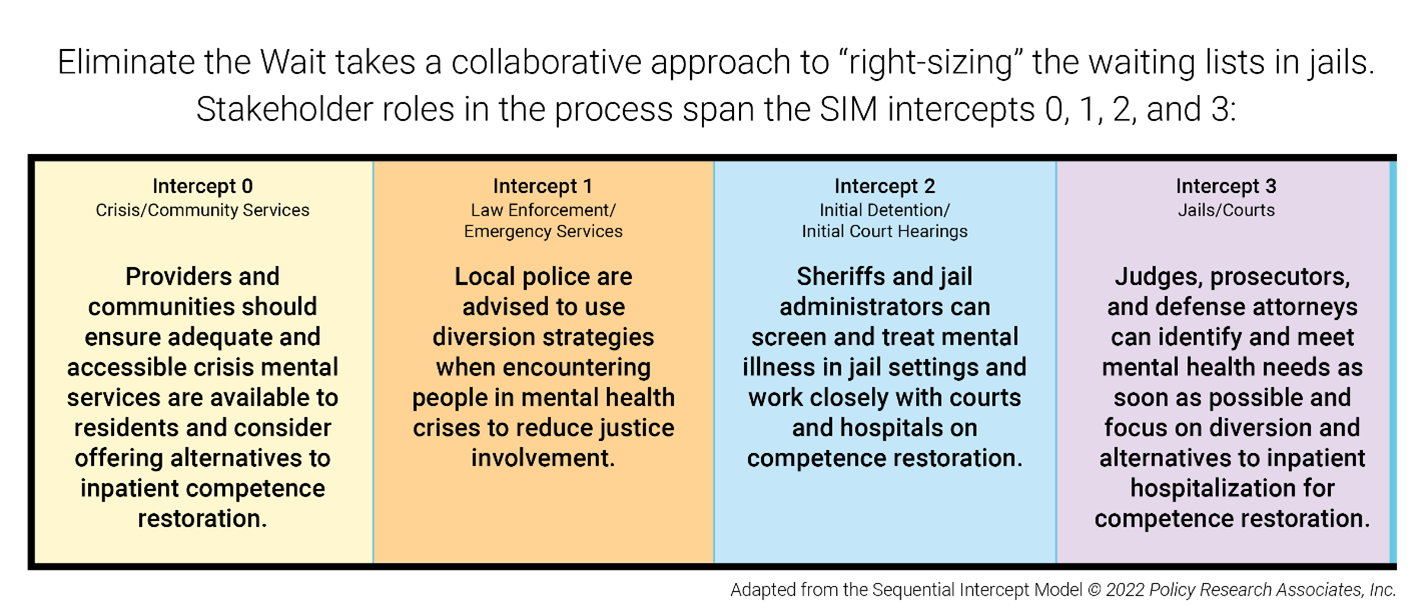There has been a dramatic increase in people found incompetent to stand trial in Texas over the past 20 years. On an average day, over 2,000 people found incompetent to stand trial (IST) are waiting in Texas jails to receive inpatient competency restoration services in a state hospital. This can overextend already overburdened county jails, which are not the best environment for people in mental health crisis or with poorly managed mental illnesses.
In 2021, a team from the Texas Health and Human Services Commission (HHSC) and the Texas Judicial Commission on Mental Health (JCMH) set out to reduce the number of people waiting in jails for inpatient competency restoration services through a public outreach and education campaign to the state’s many justice stakeholders.
The “Eliminate the Wait” initiative provides strategies and tools for partners at all points in the criminal justice system to help reduce the number of people waiting in jail for inpatient competency restoration services. The project includes training, educational materials, and tools such as checklists for police, sheriffs and jail administrators, judges and court staff, prosecutors, defense attorneys, and behavioral health providers. The comprehensive Texas Eliminate the Wait Toolkit and other materials can be found on the Texas JCMH Eliminate the Wait website. The program also created an informational video to facilitate the discussion and spread awareness about Mental Competency Consequences.
In addition to inpatient settings, competency restoration services can be provided in outpatient and jail-based settings. HHSC funds and encourages the use of both of these options as alternatives, but courts may be reluctant to use outpatient competency restoration as they balance issues of public safety with who can be treated in the community while they await trial. Additionally, there are a limited number of jail-based competency restoration programs operating in the state. As a result, many people with mental illness remain in jail while waiting for an inpatient bed. “The goal of competency restoration is stabilization, symptom management, and education on the legal process,” says Jennie Simpson, PhD, Associate Commissioner and State Forensic Director at HHSC. “It is not intended to provide comprehensive mental health treatment, although sometimes people incorrectly think it does.”
Through the Eliminate the Wait project, “we are really focused on changing behavior and practice among behavioral health and justice professionals who come in contact with this population,” says Dr. Simpson. “Each professional has a role in prevention and diversion and reducing justice involvement.” This effort primarily focuses on Intercepts 0, 1, 2, and 3 of the Sequential Intercept Model (SIM), with behavioral health providers, law enforcement, courts, and jails playing a part in reducing how many people end up waiting for inpatient competency restoration services. In the future, the initiative will also focus on Intercepts 4 and 5, recognizing the importance of reentry and community corrections in reducing the risk of recidivism.
The Eliminate the Wait project was launched at JCMH’s Judicial Summit on Mental Health in October 2021. It’s too early in the process for outcomes data, but the team continues to reach out to stakeholders and spread the word about the initiative. “We’re currently working on outreach to communities and learning what the barriers are to employing alternatives to inpatient competency restoration,” says Dr. Simpson. “From there, we can begin to build more tools to help address those barriers.” In the fall 2022, HHSC and JCMH will begin regional convenings that bring together stakeholders to examine their local forensic waitlist data, train on the Eliminate the Wait toolkit, and start community conversations about everyone’s role in reducing and eliminating the wait for inpatient competency restoration services.
Like what you’ve read? Sign up to receive the monthly GAINS eNews!



